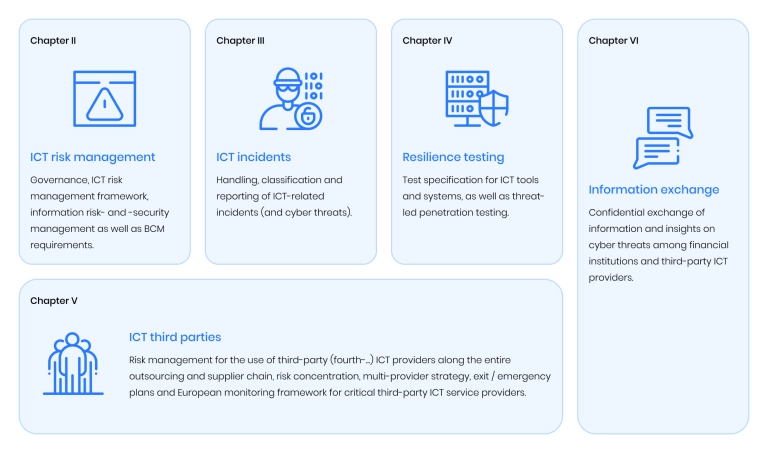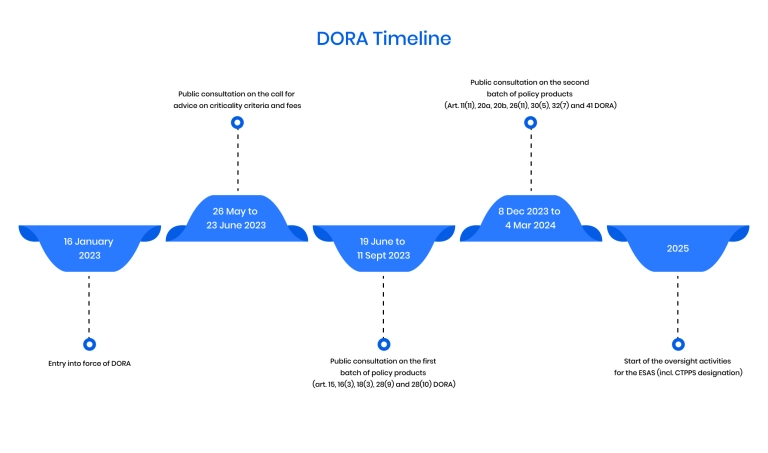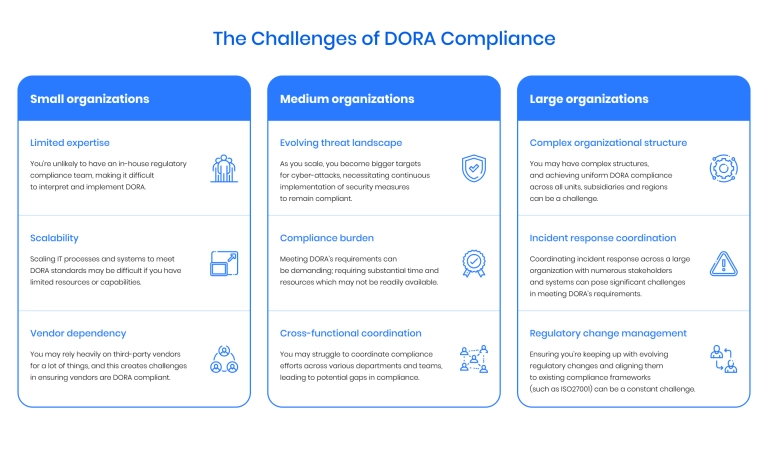The Digital Operational Resilience Act (DORA) introduces a comprehensive framework for financial firms to strengthen their ability to manage operational disruptions.
Covering IT security, incident response, and third-party risk management, DORA ensures that "all entities in the financial system are subject to a common set of standards to mitigate cyber risks and enhance operational resilience," according to the Digital Operational Resilience Act resource. This regulation addresses the increasing dependence on technology and the rising complexity of digital ecosystems within the financial sector (Source ).
Under DORA regulations, firms must implement strict measures to identify, manage, and report risks, including those stemming from third-party providers. Beyond compliance, the act compels organizations to adopt a proactive approach to digital resilience, improving operational reliability and safeguarding customer trust. While the implementation can be challenging, these changes position businesses to better withstand operational risks and adapt to future regulatory demands.
In this article, you'll learn:
- What the Digital Operational Resilience Act entails.
- The benefits of compliance for financial firms.
- Penalties for noncompliance.
- Challenges and solutions for implementing DORA.
- Insights into how other jurisdictions handle digital resilience.
- How we assist organizations in achieving compliance.
Read on to understand how financial firms can align with DORA regulations to enhance operational resilience and navigate the regulatory landscape effectively.
What is the Digital Operational Resilience Act (DORA)?
The best answer to "What is DORA?" is that it is a regulatory framework designed to enhance the financial sector's ability to withstand and recover from operational disruptions. It introduces standardized rules across the EU to strengthen IT security, risk management, and incident reporting practices for financial entities and their third-party service providers. According to the Act info, the regulation aims to "harmonize and streamline digital operational resilience requirements across all EU financial entities" (Source ).
Key provisions of DORA:

DORA's primary goal is to ensure financial institutions remain resilient against cyber threats and technology failures. Implementing uniform standards seeks to eliminate inconsistencies in how operational resilience is managed across the EU, providing a safer financial ecosystem for businesses and their customers.
Why Is DORA critical for financial institutions?
Financial institutions operate in an environment of increasing cyber threats and technological complexities. The significance of DORA compliance lies in its ability to protect firms from operational failures and reputational damage while safeguarding customer data and trust.
With the help of the Act experts, organizations can better manage risks, identify vulnerabilities in their digital infrastructure, and implement strategies to prevent disruptions. By standardizing operational resilience requirements, DORA not only enhances cybersecurity but also enables financial firms to meet regulatory expectations effectively and consistently across the EU.
Benefits of DORA compliance for organizations
Complying with DORA requirements provides financial institutions with multiple advantages beyond regulatory adherence. By implementing the Act's provisions, companies strengthen their operational frameworks, ensuring resilience against cyber threats and enhancing overall market confidence.
- Increased cyber resilience
DORA mandates robust IT risk management practices and regular testing, enabling firms to identify vulnerabilities and mitigate cyber threats proactively. Enhanced cyber resilience reduces the likelihood of disruptions, minimizing financial and reputational risks.
- Improved process transparency
By requiring transparent incident reporting and rigorous oversight of third-party providers, DORA fosters greater transparency across internal processes and external partnerships. This transparency ensures regulatory alignment and boosts stakeholder confidence in the institution's operational integrity.
- Enhanced customer data protection
With DORA financial services provisions focusing on IT governance and incident response, firms are better equipped to safeguard sensitive customer information. Strengthened data protection measures reduce the risk of breaches, fostering trust and loyalty among clients.
- Increased market competitiveness
Adhering to DORA positions financial institutions as leaders in operational excellence and risk management. This compliance not only prevents penalties but also enhances the firm's reputation, creating a competitive advantage in the evolving financial landscape.
By meeting DORA requirements, financial institutions can build a secure, resilient, and trustworthy operational framework that benefits both the organization and its clients.
What's the penalty for noncompliance?
Here is the DORA timeline, where 2025 is the key point.

Starting in January 2025, enforcement of DORA will be handled by designated regulators in each EU member state, known as "competent authorities." According to IBM, these authorities can mandate specific security measures, require remediation of vulnerabilities, and impose penalties on noncompliant financial entities. Penalties, which may include administrative or even criminal actions, will be determined individually by each member state (Source ).
Failing to meet the standards outlined in the DORA regulation summary can result in significant financial penalties, legal action, and reputational harm. Noncompliance undermines operational resilience, leaving financial institutions vulnerable to operational disruptions, regulatory scrutiny, and loss of customer trust in an increasingly regulated environment.
- Financial and legal consequences
Noncompliance can result in substantial fines, sanctions, and increased regulatory scrutiny. Investigations into breaches or operational failures can disrupt daily operations, leading to additional costs. In severe cases, noncompliant firms may face suspension of licenses or restrictions on market access, directly impacting their ability to operate.
- Reputational damage
Organizations that fail to meet DORA's requirements are at risk of data breaches or operational failures, which can severely damage their reputation. Eroded customer trust can lead to a loss of business, while negative public perception can deter future clients and investors. Restoring reputational damage requires significant resources, further straining the organization.
- Increased operational costs
Handling the fallout from noncompliance — such as addressing security breaches or responding to regulatory inquiries — can impose high, unexpected costs. This diverts resources from innovation and growth, further compounding the financial impact.
- Third-party vulnerabilities
DORA emphasizes strict oversight of third-party providers. A lack of compliance in this area can lead to supply chain disruptions and regulatory penalties for the financial institution, even if the failure originates from the vendor.
- Reduced market confidence
Noncompliance signals weak operational practices and can deter investors or business partners. Firms that fail to comply with DORA may find it challenging to compete in a market that increasingly prioritizes operational resilience and security.
As DORA establishes a comprehensive framework for digital operational resilience, compliance is not just a regulatory requirement — it is a critical step in safeguarding a firm's financial stability, operational efficiency, and long-term reputation. Firms prioritizing compliance minimize risks and position themselves for sustainable success in a competitive industry.
Challenges of implementing DORA for financial firms
Ensuring compliance with the DORA regulation presents unique challenges for organizations of varying sizes. From limited resources in small companies to complex structures in large enterprises, each type of institution faces distinct hurdles in meeting regulatory requirements.
The complexity of the Act lies not only in understanding its provisions but also in operationalizing them across IT infrastructure, vendor relationships, and cross-departmental efforts.

The challenges highlighted in the visual underscore how organizational scale directly impacts the approach to DORA compliance. Small firms struggle with expertise and scalability, while medium-sized firms deal with coordination and resource burdens. Large institutions face significant hurdles in harmonizing processes across regions and adapting to evolving regulatory demands.
Small organizations: Limited expertise and scalability
Small financial firms often lack the internal expertise to interpret and implement the Act's standards. The absence of in-house compliance teams makes aligning operations with regulatory expectations challenging. Limited IT budgets compound the problem, as scaling systems to meet resilience requirements can strain already constrained resources.
Additionally, these firms tend to rely heavily on third-party vendors, creating dependencies that introduce further complexity in ensuring compliance.
Medium organizations: Coordination and resource burdens
As medium-sized firms grow, they become more attractive targets for cyberattacks, requiring continuous investment in security measures to maintain operational resilience. However, balancing compliance demands with resource limitations is a constant challenge.
Coordinating efforts across departments often results in inefficiencies or overlooked compliance gaps, highlighting the need for streamlined processes and cross-functional collaboration.
Large organizations: Structural complexity and regulatory adaptation
With their expansive global operations, large enterprises face the daunting task of achieving uniform compliance across subsidiaries, regions, and departments. Managing incident response and aligning regulatory changes with existing compliance frameworks, such as ISO27001, require robust governance structures.
Without effective coordination, maintaining operational consistency becomes a significant barrier to meeting the DORA Act requirements.
Addressing these challenges necessitates a tailored approach that accounts for organizational size, resource availability, and existing operational structures.
How to tackle DORA compliance challenges?
Overcoming the challenges posed by DORA requires a combination of strategic planning, technological adoption, and organizational alignment. Financial firms must take proactive steps to ensure compliance while streamlining operations and reducing the burden on internal teams.
- Leverage artificial intelligence for contract analysis and updates
The DORA Act emphasizes stringent oversight of third-party vendors, which often involves analyzing and updating contracts to align with regulatory requirements. Artificial intelligence (AI) can automate contract reviews, ensuring compliance with DORA’s standards. By identifying inconsistencies and suggesting updates, AI reduces manual effort, accelerates contract management, and minimizes errors.
- Automate risk management processes
DORA’s focus on operational resilience requires continuous risk monitoring and mitigation. Automating risk management using AI-driven tools can provide real-time insights into vulnerabilities, flagging potential issues before they escalate. Automated systems streamline reporting, improve accuracy, and reduce resource dependency, enabling firms to comply with DORA’s demands effectively.
- Build cross-functional teams
Organizations must align IT, compliance, and business teams to create a unified approach to DORA compliance. Cross-functional collaboration ensures no gaps in implementation, particularly for medium-sized firms struggling with coordination across departments.
- Invest in scalable IT infrastructure
Small firms, in particular, should prioritize scalable IT systems to meet DORA’s requirements. Cloud-based solutions can provide cost-effective scalability, enabling firms to adapt to changing regulatory demands without overhauling their existing infrastructure.
- Strengthen third-party oversight
Establish robust mechanisms for monitoring third-party vendors. This includes automated compliance checks, regular audits, and contract management processes to ensure vendors meet DORA’s standards. Enhanced oversight minimizes the risks introduced by vendor dependencies, a critical challenge for smaller organizations.
- Focus on incident response readiness
Large organizations should develop clear incident response protocols integrating various stakeholders and regions. Regular drills and simulations can ensure teams are prepared to address disruptions efficiently, meeting DORA’s incident reporting requirements.
By adopting these strategies, financial firms can navigate the challenges of DORA compliance while enhancing operational resilience and efficiency. Leveraging AI and automation simplifies processes and positions organizations to meet future regulatory demands with confidence.
How other jurisdictions address digital resilience
Ensuring operational resilience in the financial sector is a global priority, with jurisdictions adopting unique approaches tailored to their regulatory environments. While the Digital Operational Resilience Act provides a comprehensive framework for ICT risk management across the EU, similar initiatives exist in the United States and the United Kingdom.
The Sound Practices for Strengthening Operational Resilience issued by the Federal Reserve, OCC, and FDIC focuses on safeguarding critical operations in the US financial institutions. Meanwhile, the Operational Resilience Framework developed by the FCA and PRA in the UK emphasizes identifying important business services and setting impact tolerances (Source , Source ).
The table below compares these frameworks, emphasizing their scope, key requirements, and regulatory approaches:
| Aspect | EU | USA | UK |
| Scope | Applies to a wide range of financial entities, including banks, insurance companies, and crypto-asset service providers. | Targets large and complex domestic banking organizations with assets ≥ $250 billion, or ≥ $100 billion with specific risk profiles. | Covers banks, building societies, PRA-designated investment firms, insurers, and recognized investment exchanges. |
| Regulatory authorities | European Supervisory Authorities (ESAs) coordinate with national competent authorities. | Federal Reserve, Office of the Comptroller of the Currency (OCC), and Federal Deposit Insurance Corporation (FDIC). | Financial Conduct Authority (FCA) and Prudential Regulation Authority (PRA). |
| Key requirements | - ICT risk management - Incident reporting - Digital operational resilience testing - Management of ICT third-party risk | - Sound practices to strengthen operational resilience - Focus on critical operations and core business lines - Tolerance for disruptions | - Identification of important business services - Setting impact tolerances - Regular scenario testing |
| Third-party risk management | Mandates oversight of critical ICT third-party service providers, including contractual requirements and monitoring. | Emphasizes management of risks associated with third-party service providers, including due diligence and ongoing monitoring. | Introduces oversight of critical third parties (CTPs) with specific rules and expectations for resilience. |
| Incident reporting | Requires reporting of significant ICT-related incidents to competent authorities within set timeframes. | Encourages timely notification of significant cyber incidents to relevant authorities. | Mandates reporting of operational disruptions that impact important business services. |
| Implementation timeline | Full compliance required by January 2025. | Guidance issued in 2020; implementation timelines vary by institution size and complexity. | Firms expected to operate within impact tolerances by March 2025. |
How we support organizations in their journey to DORA compliance
At Binariks, we focus on optimizing IT infrastructure, automating compliance processes, and building resilience to operational risks to support organizations in meeting regulatory requirements.
Comprehensive compliance support
- IT infrastructure optimization: We work with businesses to enhance the scalability and resilience of their IT systems, ensuring they meet DORA's requirements for operational continuity and risk mitigation. This includes identifying vulnerabilities and implementing strategies to strengthen digital infrastructure.
- Incident management solutions: Our team helps establish robust incident response frameworks, including automated reporting and real-time monitoring, to meet DORA's requirements for timely communication and resolution of operational disruptions.
- Vendor risk management: We streamline the oversight of third-party service providers by assisting in contract analysis, performance monitoring, and compliance alignment, ensuring adherence to DORA's standards for ICT third-party risk.
The role of DevOps in DORA compliance
Our expertise in DevOps services adds significant value to compliance efforts. DevOps facilitates integrating development and IT operations, creating a unified approach to achieving operational resilience. Key contributions of DevOps include:
- Automation: By automating routine compliance processes like risk assessments and reporting, DevOps reduces manual effort and increases accuracy.
- Continuous monitoring: DevOps practices enable real-time systems monitoring, ensuring quick identification and resolution of potential vulnerabilities.
- Scalability: DevOps supports seamless updates and scalability of IT systems, making it easier for organizations to adapt to evolving regulatory requirements.
- Collaboration: Improved collaboration between teams ensures that compliance is integrated into every stage of IT operations and development.
For more insights into how DevOps can enhance compliance and operational resilience, explore our blog on DevOps and its business advantages .
By partnering with Binariks, financial firms gain access to a team of experts who understand the nuances of DORA and the operational challenges it presents. We focus on delivering customized solutions that ensure compliance and enhance operational efficiency and resilience. Whether optimizing IT systems, implementing DevOps practices, or providing vendor oversight, our services are designed to align with your organization's unique needs.
Final thoughts
The Digital Operational Resilience Act represents a transformative step in ensuring digital and operational resilience in the financial sector.
Institutions must focus on key areas like ICT risk management, incident reporting, third-party oversight, and resilience testing to comply. By harmonizing requirements across the EU, DORA sets a unified standard, reducing regulatory fragmentation and streamlining operational expectations. Its implementation strengthens the financial sector's ability to withstand disruptions and promotes a culture of proactive risk management and accountability.
DORA's principles are highly adaptable and could influence regulatory frameworks in other industries. Sectors like healthcare, energy, and telecommunications face similar operational risks due to their reliance on digital systems. By establishing robust standards, DORA could serve as a blueprint for cross-industry regulations, fostering global resilience and setting a benchmark for digital risk management.
Share
